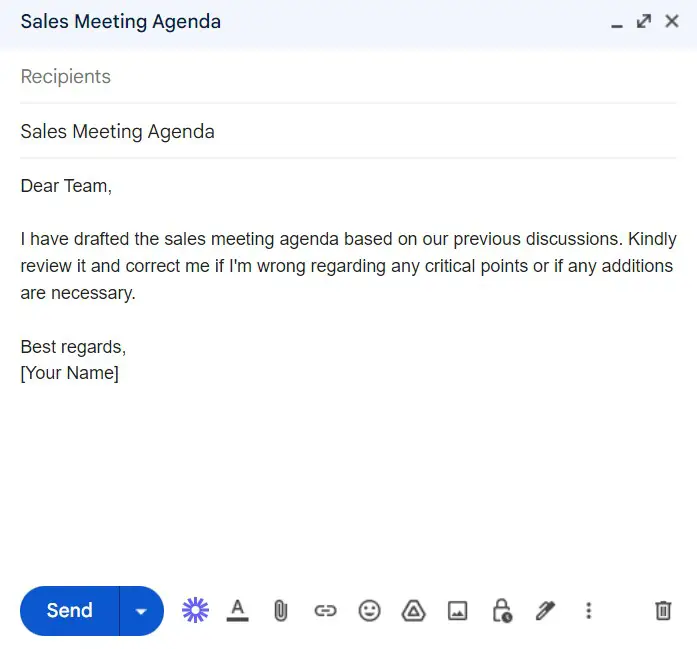Have you ever found yourself in a situation where you wanted to seek clarification or validate your understanding in an email conversation?
Effective communication is key in the professional realm, and there is a phrase that can come to your rescue: “Correct me if I’m wrong.”
In this article, we will explore how to use this phrase strategically in your email communication.
We will also provide you with a range of email examples to demonstrate its application. So, let’s dive right in!
Contents
- How to Use “Correct Me if I’m Wrong” in an Email
- “Correct Me if I’m Wrong” Email Examples
- Example 1 – Subject: Sales Meeting Agenda
- Example 2 – Subject: Project Deadline Extension
- Example 3 – Subject: Quarterly Report Findings
- Example 4 – Subject: Travel Itinerary
- Example 5 – Subject: Proposed Budget Allocation
- Example 6 – Subject: Meeting Minutes – Team Collaboration
- Example 7 – Subject: Request for Approval
- Example 8 – Subject: Technical Support Request
- Example 9 – Subject: Feedback on Presentation
- Example 10 – Subject: Proposal Review
- Alternative Ways to Say “Correct Me if I’m Wrong” in an Email
How to Use “Correct Me if I’m Wrong” in an Email
Using the phrase “Correct me if I’m wrong” in an email can serve multiple purposes. It showcases your willingness to learn, promotes open dialogue, and ensures that everyone is on the same page. Here are a few scenarios where you can employ this phrase:
1. When seeking confirmation: Use this phrase to confirm your understanding of a certain topic, seeking validation or correction if needed.
2. When seeking input: If you are discussing a complex matter or brainstorming ideas, “Correct me if I’m wrong” can encourage others to share their insights, correct any misconceptions, or provide additional information.
3. When acknowledging potential mistakes: By employing this phrase, you display humility and openness to feedback, acknowledging that you might have made an error and welcoming others to set the record straight.
“Correct Me if I’m Wrong” Email Examples
Now, let’s explore some practical examples to illustrate the usage of this phrase. The following ten email samples showcase various situations where “Correct me if I’m wrong” can be employed effectively:
Example 1 – Subject: Sales Meeting Agenda
Dear Team,
I have drafted the sales meeting agenda based on our previous discussions. Kindly review it and correct me if I’m wrong regarding any critical points or if any additions are necessary.
Best regards,
[Your Name]
Example 2 – Subject: Project Deadline Extension
Dear [Client’s Name],
I hope this email finds you well. Due to unforeseen circumstances, we may require a slight extension for project completion. Correct me if I’m wrong, but I believe an additional week would be sufficient to ensure the highest quality deliverable.
Thank you for your understanding.
[Your Name]
Example 3 – Subject: Quarterly Report Findings
Dear [Colleague’s Name],
I have analyzed the quarterly report, and I would like to discuss my findings with you. Correct me if I’m wrong, but it seems that our market share has grown significantly compared to the previous quarter. I’d appreciate your insights on this matter.
Looking forward to hearing your thoughts.
[Your Name]
Example 4 – Subject: Travel Itinerary
Dear [Travel Coordinator’s Name],
I have arranged the travel itinerary for our upcoming conference. Please review the details and correct me if I’m wrong. If any adjustments are needed, kindly let me know as soon as possible.
Thank you for your assistance.
[Your Name]
Example 5 – Subject: Proposed Budget Allocation
Dear [Manager’s Name],
I have prepared a proposed budget allocation for the upcoming project. Correct me if I’m wrong, but it seems that we have allocated a significant portion to marketing initiatives. I’d appreciate your guidance and any necessary corrections.
Best regards,
[Your Name]
Example 6 – Subject: Meeting Minutes – Team Collaboration
Dear Team,
Please find attached the meeting minutes from yesterday’s team collaboration session. Correct me if I’m wrong, but I believe we agreed to implement the proposed changes by next week. Kindly review the document and provide any necessary corrections or additions.
Thank you for your attention.
[Your Name]
Example 7 – Subject: Request for Approval
Dear [Supervisor’s Name],
I have prepared a request for budget approval for the upcoming project. Correct me if I’m wrong, but it seems that we have allocated a higher amount for research and development than initially planned. Please review the proposal and provide any necessary corrections or adjustments.
Thank you for your consideration.
[Your Name]
Example 8 – Subject: Technical Support Request
Dear [Technical Support Team],
I am experiencing an issue with the software update process. Correct me if I’m wrong, but I believe I followed all the necessary steps outlined in the user manual. Could you please review the process and provide any guidance or corrections?
Thank you for your assistance.
[Your Name]
Example 9 – Subject: Feedback on Presentation
Dear [Colleague’s Name],
I recently delivered a presentation to the client. Correct me if I’m wrong, but I believe there are areas where I can improve. I would greatly appreciate your feedback and suggestions to enhance my presentation skills.
Thank you for your valuable input.
[Your Name]
Example 10 – Subject: Proposal Review
Dear [Client’s Name],
I have drafted a proposal based on our previous discussions. Correct me if I’m wrong, but it appears that we have addressed all the requirements outlined in the project brief. Please review the proposal and let me know if any modifications or additions are needed.
Looking forward to your response.
[Your Name]
Alternative Ways to Say “Correct Me if I’m Wrong” in an Email
While “Correct me if I’m wrong” is a widely used and effective phrase, there are alternative ways to convey a similar meaning in your email communication.
Here are a few alternative expressions you can consider:
- “Please let me know if my understanding is accurate.”
- “I would appreciate your input to ensure I’m on the right track.”
- “If I’ve misunderstood anything, kindly point it out.”
- “Feel free to correct me if I’ve made any errors.”
In the realm of professional email communication, employing the phrase “Correct me if I’m wrong” can foster clarity, open dialogue, and demonstrate a willingness to learn and improve. By using this phrase strategically and incorporating it into your email conversations, you invite others to provide corrections, validate your understanding, and contribute their insights.
Remember, effective communication is essential for productive collaborations and successful outcomes.
So, go ahead and confidently utilize this powerful phrase in your emails, creating a positive and collaborative environment within your professional network.


